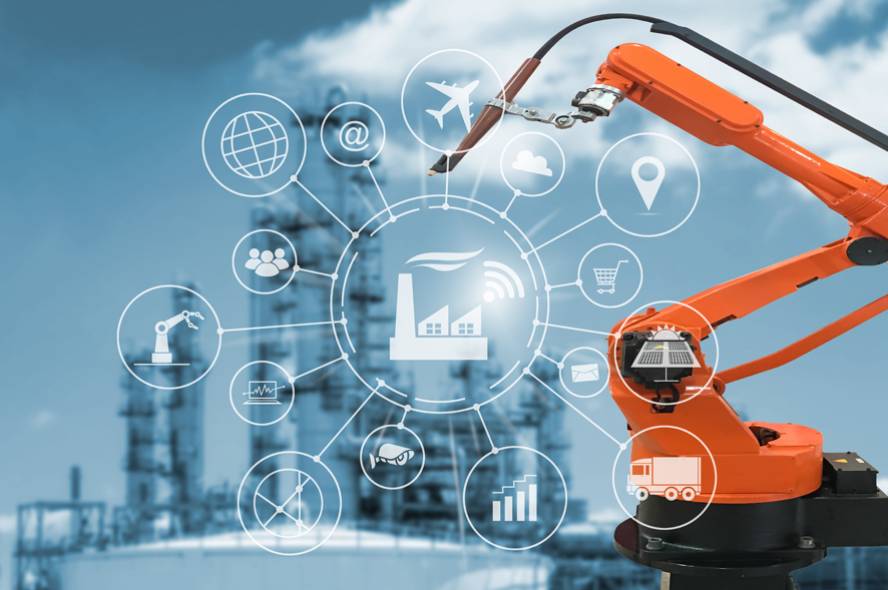
Industry 4.0: Are we facing a revolution?
In addition to the new opportunities that will open up, this joint revolution of new technologies also raises doubts about security. What are we referring to? To answer the many questions, Elhuyar organized an open debate at the San Telmo Museum. In the following pages, the views of the experts in the round table are collected and the reflections of the public can be consulted on the website of the Zientziakide project. The experts are:
Aintzane Conde Fernández, PhD in Mechanical Engineering. In his thesis he studied how to use the tools offered by industry 4.0.
Ángel Elías Ortega, jurist and dean of the Faculty of Labor Relations and Social Work of the UPV. He is a member of the Euskanpus Industry 4.0 group.
Aran García Lekue, physicist and researcher Ikerbasque at the DIPC Donostia International Physics Center. Investigate the properties of nanoscale materials.
“We are responsible for the good use of the tools of the new revolution”
Aintzane Conde Fernández
Doctor in Mechanical Engineering. Professor Advanced Manufacturing Center IMH
At this moment, industry is at the door of a revolution. It will not be the first. XVIII. At the end of the twentieth century there was a historical milestone: the creation of steam machines. This meant a change in the ways of working. The same happened with the beginning of the production in chain, second industrial revolution in the decade of 1870. Just over 100 years, it brought with it a third revolution. And today we are living a fourth revolution in tune with the connectivity and use of data: Industry 4.0.
Within the framework of this fourth revolution, in recent years we have experienced many advances. Without realizing it, we have many devices that differentiate our face from many others, who know us in photos, who fulfill orders through our voice. In our day to day we already have very internalized these technological improvements or many options that facilitate our life in the field of home automation. This pioneering transformation in the field of communication has also been reflected in industry, as is the case of the current revolution, industry 4.0. But what brings us this new way of working?
Management without barriers On the one hand, we believe that this transformation based on connectivity will make automatic and autonomous work possible. The products will become services and with it we will increase traceability and control. In the management will also be evident the change, since we can send diverse actions from the mobile to many kilometers. That is, we will not detect barriers.
On the other hand, there is a new manufacturing process among the main agents, which we call additive manufacturing. It is an innovative way to produce parts in which machines are used that “print” the parts from the beginning instead of machining. This form of manufacturing has reported important benefits by increasing the possibilities of material production and construction of complex geometries, as well as enabling prototyping. This technology, which until now has been used in the repair of some parts, such as the aeronautical and automotive sector, will be used in the future to manufacture parts from the beginning. In addition, we have auxiliary elements that will serve to facilitate the work, as tools for analyzing large amounts of data, collaborative robots and virtual reality. Virtual reality can also be a great saving, since we will have at hand the traceability of the pieces and processes before their execution.
Safety in the destination and safety in the head. In this sense, we can easily see examples of the everyday: we have some photos and files protected in the network, linked with multiple devices through which complex connections are constructed. And when we introduce a storage device (USB) it is easy to introduce a virus into this internal IT network. This can happen in a fully digitized and connected workshop. Therefore, in addition to protecting the security of external aggressions, it must also protect itself from internal attacks and risks.
Training will ensure a responsible attitude, although we have already mentioned the main characteristics of Industry 4.0, we should also reflect on its effects on people. Will the number of unemployed increase? Will it involve changes in the number of working hours or in working conditions? As I commented at the beginning, industrial revolutions in general open up new ways of life and work, but we must discuss whether they are positive or not. I think the tools that technology offers us are good, but it is only society, or it should be society's, responsibility for the good use of these tools. And the most important and basic thing we can do to do this is to facilitate training in all areas, not only technological, so that the changes are carried out in a responsible and human way. If technology is going to transform our society, through training it will be in our hands to prepare society for change.
“Who are those who control technological advances?”
Angel Elías Ortega
Jurist and dean of the Faculty of Labor Relations and Social Work of the UPV
In the last 200 years we have found that four industrial revolutions have altered demography, nature, climate, biodiversity, life expectancy, quality of life and even forms of power. We must ask ourselves for what new technologies and advances in knowledge. The discovery of the atom can be great advances, but also great risks. The same happens today with advances in numerous scientific fields.
The regulation of the markets provokes the formation and creation of qualifications for those professions in which the contribution to the satisfaction of the social needs is low and, in many cases, far from generating wealth, only change from one hand to another, always under the control of the most powerful. Therefore, it is necessary to question the essence of many degrees and professions, and to analyze their capacity to respond to the needs and challenges of society and the vocational development of each subject.
Where technological advances are directed Who has economic power also influences politics and the decision on the direction of technological advances. Therefore, we must ask ourselves who are the subjects who drive, finance and control them.
Likewise, we must ask ourselves about the role of the public sector, for example, in the field of research, the tendency to finance public universities predominates with contributions of patronage and private funds, which will undoubtedly condition the orientation and direction of the investigations.
The wealth generated, elitAfter the Second World War, the Universal Declaration of Human Rights and several international agreements that develop it, have signed almost all states that commit themselves to guarantee the well-being and to progressively improve the living conditions of each citizen. For example, the Spanish Constitution establishes in its article 128.1 that: “All the wealth of the country, in all its forms and regardless of its ownership, depends on the general interest.”
At the international level, following the Universal Declaration of Human Rights, the International Covenant on Economic, Social and Cultural Rights, in Article 2.1, states that: “Each Member State of the present Covenant undertakes to take measures, especially economic and technical, by itself or through international assistance and cooperation, until it reaches the maximum available resources, by all relevant means, including the adoption of legislative measures, progressively, to achieve the full effectiveness of the rights recognized here.”
However, in a clear contrast with the above, and substantially contravening the legal mandate already analyzed, there is today an extreme difference between assets and income and fantastic works and other garbage. Reality shows us that in the markets there are small elites who control wealth and power. And with the new technologies they seek to promote their economic interests and increase their power, being strategic sectors those related to the development of the military industry, as well as all forms of energy production, communication, biotechnology and pharmaceutical industry.
In favor of an equitable distribution, I believe that thanks to artificial intelligence and new technologies, wealth is now abundant, but we have to bet on an equitable distribution, which is materialized by the universalization of social rights and a distribution of employment time that avoids unemployment and excessive work. This is the best social and economic investment that will allow us to advance in a better society, since people can develop it entirely.
To finish, what does the distribution of wealth and time of employment guarantee? Among them, a greater personal freedom and social cohesion, a strategy of prevention and saving expenses, the growth of social services that improve the quality, support for youth and their creativity and the development of values in the framework of human rights.
“With the molecules we can already play as lego pieces”
Egüés Valley
Physicist and researcher Ikerbasque at the DIPC Donostia International Physics Center
The nanometer, of a billion meters, is the measure of atoms and molecules. The organization among these tiny objects determines the electrical, optical, thermal and mechanical properties of various materials of nature, among others. In addition, compared to macroscale, these properties are often very special in nanoscale structures, since quantum effects appear in these sizes. Nanoscience and nanotechnology aim to investigate and transform those extraordinary characteristics that occur at the atom scale. Based on knowledge and knowledge acquired, it is possible to develop new materials and/or nanoscale devices with a given function. Thus, nanotechnology will have a great influence on areas such as electronics, medicine or the environment.
The momentum of nanotechnology in recent decades has led us to live surrounded by nanomaterials or nanodevices: mobile, computer, cosmetic products, clothing... But for this revolutionary technology to advance it is not enough to create “very small things”, it is necessary that manufacturing can be done with great precision. For this reason, new nanofabrication methods are being developed continuously. Top-down (descending) methods are common. For example, lithography, where nanoscale structures can be obtained from a greater part of material. Although these methods are increasingly accurate, they do not allow for atomic precision. For this reason, in recent years the new procedures called bottom-ups (from bottom to top) have been strengthened, in which the molecules self-organize individually creating new structures. Because the nanostructures thus manufactured maintain the atomic structure of the initial molecules, the desired material can be controlled atom by atom.
Nanotechnology is a major step forward in atomic precision. For example, recently, following the bottom-up pathway, we have achieved a nanoporous graphene that can be used as a sensor to separate water molecules from one in one. This can report a huge benefit in many parts of the world to perform such a necessary water cleaning. On the other hand, it is clear that maximum precision is of paramount importance in emerging technologies for nanomedicine such as DNA sequencing techniques. As it could not be otherwise, in the field of quantum computing that has recently become popular, manipulation and control of individual atoms is also essential.
However, in order for these advances to be truly revolutionary from the laboratory, it is necessary to leave the ideal conditions of the laboratories and take the step to urban conditions, since many of the aforementioned nanostructures fulfill the function that of them is expected only at very low pressures and/or temperatures. The superconductors currently used in quantum computing, for example, work at temperatures close to absolute zero (-273 °C). In addition to scientific and technological viability, the price must be competitive to make social inclusion a reality. However, it is worth mentioning the growing number of products in the market based on nanomaterials or nanostructures, predictably growing.
Nanomaterials in the air In addition, safety is an indispensable condition for the commercialization of products and devices based on nanostructures. Due to their small size, nanostructures that may be present in the air can be introduced into the human body (mainly through the lungs or skin) or dispersed in the environment (mainly through the soil or water). For this reason, it is being investigated in this area in order to foresee and understand the short-term and long-term effects of nanomaterials on people, animals and plants. It should also be noted that numerous research centers and organizations, such as the European Commission, have specific working groups to investigate the risks of nanotechnology and establish appropriate laws in this regard to ensure safety.








